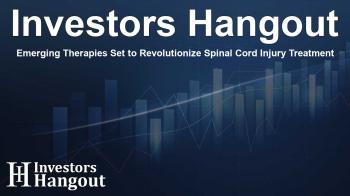Emerging Therapies Set to Revolutionize Spinal Cord Injury Treatment

Steady Growth in the Spinal Cord Injury Market
The spinal cord injury (SCI) market is poised for significant growth with a projected compound annual growth rate (CAGR) of 15.4% from 2024 to 2034. This surge will stem from the development of innovative treatments like KP-100IT, Neuro-Cells, Elezanumab (ABT-555), and MT-3921, which are all in various stages of research and clinical trials.
The Complexity of Spinal Cord Injuries
Suffering from a spinal cord injury can drastically alter an individual's life due to the complexity and variability of these injuries. The implications of an SCI can manifest differently depending on the degree and location of the spinal cord damage, leading to a range of challenges, including motor and sensory dysfunction. Because SCI can occur due to diverse causes such as trauma or disease, understanding the underlying factors is crucial for providing effective treatment options.
Current Status of SCI
As of recent estimations, approximately 959,000 individuals are living with SCI across the major markets, with projections indicating this number will continue to rise significantly by 2034. Specifically, the U.S. alone has reported around 19,000 new cases annually, underscoring the urgent demand for advanced treatment solutions.
A Necessary Shift in Treatment Approach
Despite the introduction of several therapies, the treatment landscape for SCI remains limited. Currently, only STEMIRAC is an approved therapy in Japan, while LYRICA (pregabalin) is recognized as the only FDA-approved medication specifically for neuropathic pain associated with SCIs. The focus is shifting towards more effective treatments that not only manage symptoms but also target the root causes of injury.
Innovative Therapies Coming to the Forefront
Among the new therapies, STEMIRAC, developed by Nipro Corporation, showcases a promising approach by utilizing autologous mesenchymal stem cell therapy. This innovative method extracts stem cells from patients, expands them in laboratory conditions, and later administers them to promote tissue repair directly at the injury site, contributing profoundly to the regenerative process.
What Promises STEMIRAC Holds
Having received conditional market approval, STEMIRAC is in continuous assessment to confirm its long-term efficacy. Initially approved for subacute SCI, recent trials have expanded its applications, aiming to broaden its scope and effectiveness significantly.
Future Drug Candidates in Development
The development pipeline presents a handful of promising candidates, including KP-100IT, Neuro-Cells, MT-3921, and Elezanumab. Each of these candidates is designed to tackle SCI from different angles, offering hope for better patient outcomes and faster recovery processes.
KP-100IT and Its Research Journey
KP-100IT, by Kringle Pharma, is focused on safeguarding nerve cells and facilitating axonal growth, which could dramatically improve recovery times for acute SCI patients. Having shown positive preliminary results, this therapy is undergoing extensive trials to assess its potential fully.
Neuroplast's Neuro-Cells and Its Impact
Neuroplast’s Neuro-Cells represents another leap forward, aided by stem cell technology that fosters regeneration within the central nervous system. With promising clinical results, this therapy is on the brink of making a significant impact in treating traumatic spinal cord injuries.
Understanding MT-3921's Role in Recovery
MT-3921, in collaboration with Osaka University, seeks to improve patient recovery by inhibiting molecules that impede neuronal survival and regeneration. This approach aims to enhance recovery for patients, targeting SCI with a thoughtful understanding of the underlying biological processes.
Transforming the Landscape of SCI Treatment
The anticipated introduction of these innovative therapies underscores the market's transformation, paving the way for improved patient care standards and greater opportunities within healthcare sectors. As knowledge expands and development progresses, we stand on the brink of notable improvements in SCI treatment approaches, shaping the future for countless affected individuals.
Frequently Asked Questions
What is the projected growth rate of the SCI market?
The SCI market is expected to grow at a CAGR of 15.4% from 2024 to 2034.
What treatments are currently available for SCI?
Currently, STEMIRAC is the only approved treatment in Japan, while LYRICA is the sole FDA-approved medication for neuropathic pain related to SCI.
How many individuals are affected by SCI?
Approximately 959,000 individuals are living with SCI across the major markets, and this number continues to grow.
What is the role of KP-100IT in SCI treatment?
KP-100IT is being researched for its potential to protect nerve cells and improve motor function recovery in patients with acute SCI.
What advancements are being made in SCI therapies?
Innovative therapies like Neuro-Cells and MT-3921 aim to enhance nerve regeneration and improve functional recovery for SCI patients.
About The Author
Contact Dylan Bailey privately here. Or send an email with ATTN: Dylan Bailey as the subject to contact@investorshangout.com.
About Investors Hangout
Investors Hangout is a leading online stock forum for financial discussion and learning, offering a wide range of free tools and resources. It draws in traders of all levels, who exchange market knowledge, investigate trading tactics, and keep an eye on industry developments in real time. Featuring financial articles, stock message boards, quotes, charts, company profiles, and live news updates. Through cooperative learning and a wealth of informational resources, it helps users from novices creating their first portfolios to experts honing their techniques. Join Investors Hangout today: https://investorshangout.com/
The content of this article is based on factual, publicly available information and does not represent legal, financial, or investment advice. Investors Hangout does not offer financial advice, and the author is not a licensed financial advisor. Consult a qualified advisor before making any financial or investment decisions based on this article. This article should not be considered advice to purchase, sell, or hold any securities or other investments. If any of the material provided here is inaccurate, please contact us for corrections.

